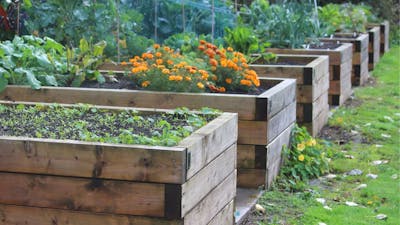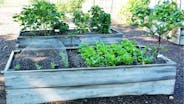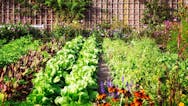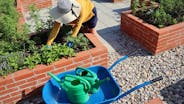© 2025 BuilderBarb.com
2506 Ada Drive Suite 3-501107, Elkhart Indiana 46514
All Rights Reserved
This site is not a part of the Facebook website or Facebook Inc.
Additionally, this site is NOT endorsed by Facebook in any way.
FACEBOOK is a trademark of FACEBOOK, Inc.
This site is not a part of Google™ website or network of sites such as
Youtube™ or any company owned by Google™ or Youtube™.
Additionally this website is not endorsed by Google™ Youtube™ Inc. in any way.
Google™ is a trademark for all their respective companies.

Benefits of Raised Garden Beds
How to Build Your Own Raised Garden Beds for Sustainable Living
Raised garden beds are an excellent choice for gardeners looking to enhance their gardening experience. These elevated beds improve soil conditions, extend the growing season, and reduce the aches and pains associated with kneeling and bending. Whether you're a seasoned gardener or a green-thumb novice, this guide will walk you through everything you need to know to build your own raised garden beds.




Before we dive into the building process, let’s briefly outline the advantages of raised garden beds:
1. Improved Soil Conditions: Raised beds allow you to control your soil more effectively, optimizing the health of your plants.
2. Enhanced Drainage: These beds facilitate better drainage, crucial for healthy plant roots.
3. Fewer Weeds: With a more controlled environment, raised beds tend to have fewer weeds.
4. Easier on Your Back and Knees: Since they're elevated, they require less bending, making gardening easier on your body.
5. Extended Growing Season: The soil in raised beds warms up more quickly in spring and stays warm longer into the fall.
Choosing the Right Location
Selecting the right spot is crucial for the success of your garden. Consider the following:
• Sunlight: Most vegetable plants require at least six to eight hours of direct sunlight per day. Observe your yard throughout the day to find a spot that receives ample sunlight.
• Accessibility: Ensure the location is easily accessible for watering and harvesting.
• Drainage: Avoid areas where water tends to collect. Good drainage is key to preventing root rot and other moisture-related issues.
Materials Needed
To build a basic raised garden bed, you will need:
• Lumber: Cedar and redwood are resistant to rot and pests. Avoid treated lumber that can leach harmful chemicals into your soil.
• Screws: Use galvanized or stainless steel screws to assemble your frames.
• Landscape Fabric: This will help prevent weeds from growing up from the ground below.
• Soil: Choose high-quality garden soil mixed with compost to fill your beds.
• Tools: You'll need a drill, a saw, a tape measure, and a staple gun.
Designing Your Raised Beds
When designing your raised garden beds, keep the following in mind:
• Size: Common dimensions are 4 feet wide by 6 or 8 feet long. Keeping the width to 4 feet allows you to easily reach the center of the bed from both sides.
• Height: Aim for at least 6 to 12 inches in height. If bending is a concern, make your beds taller.
• Shape: While rectangular beds are common, you can also consider L-shaped or circular beds depending on your space and aesthetic preferences.
Step-by-Step Construction
Plan Your Design: Sketch out your design to determine how much material you will need.
1. Cut Your Lumber: Based on your design, cut your lumber to the desired dimensions. If you’re not comfortable with power tools, most hardware stores will cut the wood for you.
2. Assemble the Frame: Lay out the pieces on a flat surface and connect the sides using screws to form a rectangular or square shape.
3. Prepare the Site: Clear the area of grass and weeds. Level the ground to prevent water from pooling.
4. Install Landscape Fabric: Cut enough landscape fabric to cover the bottom of your garden bed. This will prevent weeds from growing into your bed from below.
5. Position the Frame: Place the frame on the cleared and leveled site. Staple the landscape fabric to the inside of the frame to keep it in place.
6. Fill with Soil: Mix your soil with compost and fill your bed. Rake the soil to make it level and smooth.
Maintaining Your Raised Bed
With your raised bed in place, maintenance is straightforward:
• Watering: Keep the soil moist but not waterlogged. Raised beds may require more frequent watering as they drain better.
• Fertilizing: Supplement your soil with organic fertilizers as needed to nourish your plants.
• Weeding: Although weeds are reduced, keep an eye out and pull any weeds that appear.
Planting and Maintenance Tips
With your raised garden bed constructed and filled, you're ready to plant. Here are some tips to ensure your garden thrives:
• Choose the Right Plants: Consider the climate and the amount of sun and shade your garden bed receives. Some crops, like tomatoes and peppers, thrive in full sun, while others, such as lettuce and spinach, prefer partial shade.
• Regular Watering: Raised beds may dry out faster than traditional gardens. Monitor the moisture level and water as needed to keep the soil consistently moist.
• Seasonal Care: Add mulch to help retain moisture, and replenish the soil with compost each planting season to keep it rich and fertile.
• Rotate Crops: Avoid planting the same vegetable in the same spot each year to prevent depleting the soil of specific nutrients and reduce the risk of pest buildup.
Building a raised garden bed is a rewarding project that can simplify gardening while boosting your garden’s productivity. With your new raised bed ready, you can enjoy the numerous benefits and the fruits of your labor with less strain and greater pleasure.
Happy gardening!